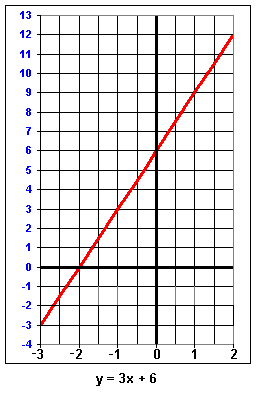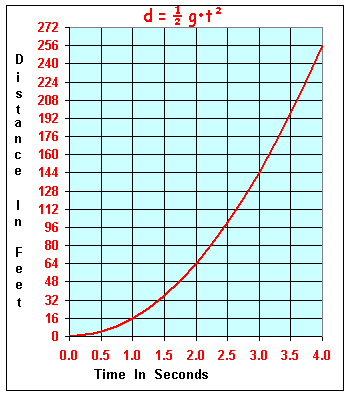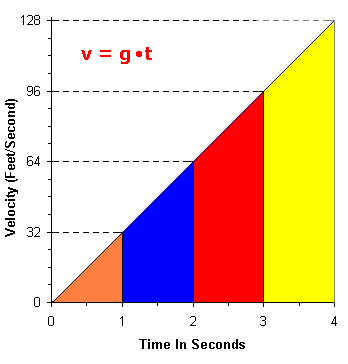|

Among other things, calculus involves studying analytic geometry (analyzing graphs). The above graph should be familiar to anyone who has studied elementary algebra. The horizontal axis is the 'X' axis and the vertical axis is the 'Y' axis.
The primary concern of
differential calculus is determining slopes
of equations.
When dealing with a linear (straight line) equation, this is relatively easy.
The slope of a line (designated by the letter 'm') is defined as the
difference in 'y' divided by the difference in 'x'. (or the "rise over the run" as it is sometimes called). 
Mathematicians use the Greek letter delta "Δ"
to represent "difference" and so this equation could be written:  Using y=3x + 6 (the red line in the graph above), we take the 2 points (x=2, y=12) and (x=-2, y=0) and calculate the slope:
 There is an easy method to calculate the slope of linear equations. For equations of the form y = a x + b = 0, the slope equals 'a' (the coefficient of 'x'). This is better than choosing points and calculating differences don't you think ? Just one more quick example - what is the slope of 5y = -3x + 7 ? Since the equation has to be of the form y = ax +b then y = -3/5 x + 7/5 and so the slope = -3/5.
In the previous section, we learned how to calculate the slope of a linear equation (equations
whose exponents = 1). 
The graph above is based on a quadratic equation which predicts the distance an
object has fallen (the y-axis) in relation to time (the x-axis). You cannot state one
specific slope for this equation because the slope is constantly
varying. What can be calculated is the slope at any point along
the curve. Let's calculate the slope when time = 3 seconds.
The formula states the distance (in feet) = ½ • g • t² (where g = 32 feet/sec²). So, when t = 3
seconds, d= ½ • 32 • 3² = 16 • 9 = 144 feet. But what do we do for choosing a second point? We could try using a value of t= 4 seconds, remembering this is not the same slope at t=3. So, we get: d= ½• 32 • 4² = 16 • 16 = 256 feet. Now, we have our second set of values: 
Why don't we choose a closer value of x such as 3.1? When that is the case, the distance equals 153.76 feet and our slope is:

How about choosing a value of x that is even closer to 3 than 3.1 ? Besides representing a difference, Δx (called 'delta x') also represents the smallest possible quantity greater than zero. Δx is less than a millionth, less than a trillionth - it's 1 divided by infinity. So, when x2 = 3 + Δx , then y2 equals
and the slope at x = 3 can be calculated as: 
Although the above method does work, it has 2 drawbacks - it is rather cumbersome and it only calculates the slope at one particular point. If we wanted to know the slope at x = 2, we would have to go through all those calculations again. Is there an easier way for determining the slope of an equation at any point? Yes !
n • k • x (n-1)
Having determined the derivative, we can put it to use by the previous example when we calculated the slope for x=3. When x = 3 (or time = 3 seconds), the slope = 32 • 3 or 96. WOW that's a lot easier huh? What about the slope at 2 seconds ? 32 • 2 equals 64.
And what is the purpose of all this
slope measuring ? In this equation, every time
we determine a slope at a particular point in time, we are calculating velocity. So, at
time = 2 seconds, an object has fallen 64 feet and has a velocity of 64 feet per second.
When time = 3 seconds, distance = 144 feet and velocity = 96 feet per second.
Just a few more comments. The derivative of a constant (for example the number 7) is always
zero. So, by way of example, the derivative of x² + 7 is 2•x. Also, if an equation
has more than 1 'x' term, simply differentiate each term and then sum those derivatives.
As we learned, differential calculus
involves calculating slopes and
now we'll learn about integral calculus
which involves calculating areas.

The above graph where velocity = g • T (or v = 32 • T), is based on the derivative of the second graph equation d= ½ • g • t². Now, if we wanted to determine the distance an object has fallen, we calculate the "area under the curve". Yes, the "curve" in this case is a straight line but the principles of integral calculus still apply.
If we calculated the sum of the orange, blue and red areas this would equal the distance
fallen after 3 seconds.
So how were we calculating these areas ? We multiplied the y-axis (which is the quantity
g • T) by the x-axis (time in seconds or 'T') and we multiplied this by ½ . So we
calculated the area by the formula ½ (g • T • T) which equals ½ • g • T², and this is the
precise formula which was used in the previous section !!

Example 1: What is the integral of 5x² + 3x -7 ?
Example 2: Here's an interesting example of integral calculus.
Well congratulations !! If you have read this tutorial carefully, you now have a good
understanding of calculus (both differential and integral) !! Granted, this was a very quick,
"bare bones" explanation, and it represents a very small tip of an incredibly huge "Calculus Iceberg".
However, you now understand the "big picture" of what calculus is all about.
As a bonus, the calculator below will help you determine derivatives and integrals.
Copyright © 1999 - 1728 Software Systems |